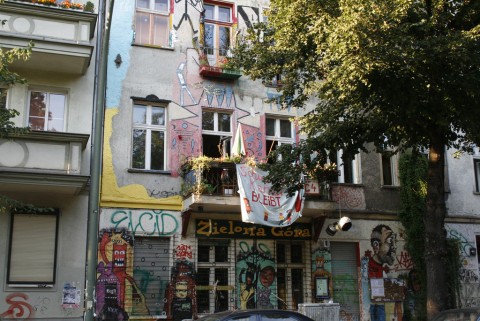On Monday, April 17th, The Urban Democracy Lab and Deutsches Haus at NYU presented a panel, “Welcome to the Occupation: Squatting and Resistance from Berlin to New York” to discuss urban precarity, squatting, and urban social movements. Panelists included cultural anthropologist Amy Starecheski, writer/activist and former squatter Frank Morales and Associate Professor in Human Geography Alexander Vasudevan. Geographer Pierpaolo Mudu moderated the event.
Squatting, or the “illegal occupation of property used without the previous consent of its owner, which could be a public institution, a particular individual, a private corporation or any sort of organization,” has implicit political and symbolic meanings, according to The Squatters’ Movement in Europe: Commons and Autonomy as Alternatives to Capitalism by Cattaneo, Claudio, and MartiÌnez. The occupation of a space can be used to protest against housing shortages, capitalism, speculation, exploitative landlords, and displacement. This urban social movement also emphasized the convention of civic participation. The occupancy resistance turned the city into a key site of political contestation where everyday citizens fight for their rights and challenge local policymakers over decisions that will directly impact their lives.
Squatting has different phases: occupation, installation, habitation and eviction. Since squatting includes the reparation and maintenance of a building, it is considered to be a kind of generative urbanism, a means of placemaking in the midst of a landscape that may have been destroyed or stripped of adequate housing opportunities.
Vasudevan, the author of Metropolitan Preoccupations: The Spatial Politics of Squatting in Berlin and the forthcoming The Autonomous City: A History of Urban Squatting, started off the evening by discussing his work and the various cultural and political qualities of squatting in Berlin. His book delves into several interrelated perspectives on the everyday practice of squatters in the city.
Vasudevan explains how Berlin squatters spatialized events of anti-authoritarian movements, creating a geography of conviction and solidarity. Additionally, squatting served as an alternative space of inhabitation that re-conceptualized our understanding of urban politics and housing scarcity. In his two books, Vasudevan invites readers to step in alongside squatters as urban archivists and custodians. Squatters were able to cultivate the ethos of autonomy, makeshift urbanism and DIY practices to provide a collective support network. These urban activists were some of the first groups of people to discover the creative, autonomous value in abandoned spaces. Today, these abandoned and interim spaces are often used to brand Berlin as a creative city. Berlin re-developers saw the subculture of squatting as a way to bring alternative social movements into the urban mainstream by painting Berlin as a “young, vibrant and creative city”. However, Vaseduvan admitted, the squatting movement diverged and had discontinuities among the Berlin community. Ultimately, Vaseduvan and the other panelists view squatting as being undeniably tethered to scarcity as a result of the capitalist system.
Squatting, and the politics surrounding it, differed in New York City than in Berlin where there was a European tradition of social democracy. Berlin’s city government had welfarist tendencies whereas New York City bureaucrats were moving towards privatization in the wake of the fiscal crisis, when resources for social housing had been cut and diminished. This means that the cities differed in their politics of legitimacy surrounding occupied urban spaces.
Amy Starecheski, an oral historian, anthropologist and former squatter, presented her findings and oral histories on the squats of the Lower East Side in the mid 1980s and late 1990s. The Lower East Side squatting movement combined urban homesteading with local Hispanic anti-urban displacement movements and DIY punk ethics. Starecheski emphasized the notion that squatters are urban archivists. New York City Squatters fought for legitimacy through direct action and resisting eviction. She presented an oral history of a former European squatter who moved to New York City wherein he discussed the run down, dilapidated state of the buildings when the squatters first moved in. Starecheski also showed photos of squatters rebuilding brick walls at 290 East 7th street, demonstrating the act of generative urbanism. However, the narrative that the Lower East Side was completely abandoned wasn’t completely truthful—there were people living there and fostering a vibrant, diverse community. Yet the decrepit nature of the Lower East Side ostensibly positioned the neighborhood as a frontier, ready for resettlement. Like Vesudevan, Starecheski also discussed some of the diverging ideologies amongst the movement. Some squatters sought ownership and legal occupation as a goal; they wanted to evoke change through legal leases and policy victories. But others did not have this aim. Some squatters wanted to occupy as a critique from a far left or anarchist perspective.
Frank Morales spoke next. He began squatting in the 70s in the South Bronx and later occupied buildings in the East Village. Having grown up on Avenue D, Morales wanted to return to the East Village later on in his life but found the rents too high so he joined the squatting movement, which he described as having a ‘spontaneous’ nature. Morales discussed how the movement began to consolidate around mutual defense, and the ability to respond rapidly to deploy quickly in the face of eviction. The community was very diverse in terms of age and race, and there was a large network of communication and support. Morales discusses the liberation that accompanies occupying buildings, how one can depart from the “wage-slavery” of a salary job. Once you have time to focus on art or academia, Morales explained, there is a sense of freedom and creativity that is unleashed. The precocity of housing, according to Morales, is the consequence of capitalists and elite managers. However, the re-appropriation of land is a form of resistance to state repression. Morales states, “Squatting is the antidote to Trumpism.” It allows for a concrete and recognizable way to care for our neighbors, striking at the heart of the “super landlord that is Donald Tr*mp”.
When asked about changes in—and whether there has been a dismantling of—the welfare state, the panelists had several perspectives. Starecheski noted that Americans don’t have a model for thinking about housing as a common good or a human right. In general, Starecheski explained, we consider collectively owned housing to be only for the socially marginalized. Vesudevan, on the other hand, explained that adopting squatting practices can generate neighborhood action and create a wide debate which can foster change. He cited the mayor of Barcelona as an example of a public figure emerging out of the squatting movement. Morales argued that the squatting movement attacks the root of a system of speculation on land, which eventually creates a platform for discussing new models to foster real, revolutionary change. Morales contended that we need to create laws that criminalize speculation. But first, the people need the power. In order to re-appropriate land, according to Morales, social movements have to get out on the streets to bring the conversation about alternative housing models into the room and pass new laws.
Overall, squatting movements have proven successful in reconceiving the spatial politics of the city as a key site for political revolt and action. In Berlin, squatting grew out of radical left-wing politics and served as a model for mainstream urban regeneration that highlighted the importance of DIY values in communities. But, the squatting subculture has been co-opted as a means of rebranding the city as creative and cultural hub. Similarly, in New York, the products of squatting culture that were once considered radical (co-ops, community gardens, and bike repairs) are now taken for granted and seen as what makes the area appealing to real estate developers and gentrifiers. Many of the notions of the squatting movement, which were considered radical, have become normalized and even encouraged in today’s creative cities. These aspects include urban homesteads, grassroots organization, community youth centers, and the idea of fostering neighborhood solidarity through civic initiatives. But ultimately, squatters in both cities developed a new understanding of urban space; they protested and continue to fight against decay and scarcity by emphasizing re-appropriation and the right to the city. Through the squatting movement, Berliners and New Yorkers alike shed light on the value the right of the urban citizen, the importance of having creative neighborhoods and housing as a right rather than a privilege.


